 |
 |
 |
| |
Skeletal muscle toxicity associated with raltegravir-based combination anti-retroviral therapy in HIV-infected adults
|
| |
| |
Reported by Jules Levin
14th International Workshop on Co-morbidities and Adverse Drug Reactions in HIV
July 19-21, 2012
Washington, D.C., USA
Frederick J Lee1, Janaki Amin2, Mark Bloch3, Sarah L Pett2, Debbie Marriott4 and Andrew Carr1
1 Clinical Research Program, St. Vincent's Centre for Applied Medical Research, Sydney, Australia; 2 The Kirby Institute, Faculty of Medicine, University of New South Wales, Sydney, Australia; 3 Holdsworth House Medical Practice, Sydney, Australia; 4 Department of Microbiology and Clinical Infectious Diseases, St. Vincent's Hospital, Sydney, Australia
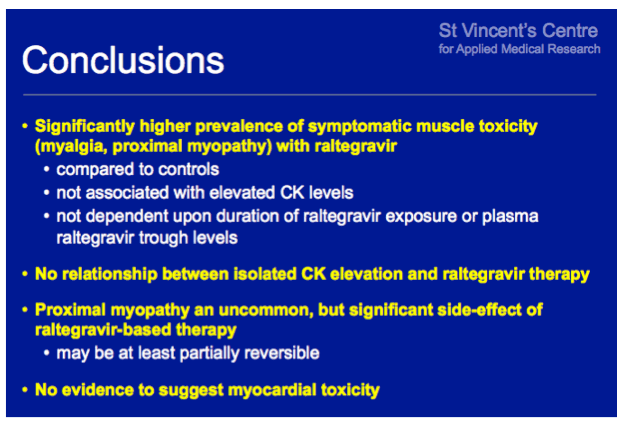
ABSTRACT
Skeletal muscle toxicity associated with raltegravir-based combination antiretroviral therapy in HIV-infected adults
FJ Lee1, J Amin2, M Bloch3, SL Pett1,2, D Marriott1, A Carr1
1Clinical Research Program, St Vincent's Centre for Applied Medical Research, Sydney, Australia; 2The Kirby Institute, University of New South Wales, Sydney, Australia; 3Holdsworth House Medical Practice, Sydney, Australia
Objectives/aim: The HIV-1 integrase inhibitor raltegravir is associated with rare cases of rhabdomyolysis, and pooled safety data from Phase II and III clinical trials show a higher rate of grade 3-4 creatine kinase (CK) elevation in patients receiving raltegravir versus controls (4.2% versus 2.5%). We compared the frequency of skeletal muscle toxicity in HIV-infected adults receiving raltegravir compared to a control group not receiving raltegravir, analysed for associated factors and also assessed for evidence of myocardial toxicity.
Methods: We consecutively evaluated 159 patients receiving raltegravir and 159 receiving non-raltegravir-based treatment (control group). No restrictions were placed on statin use or recent physical exercise for study entry. Patients with an acute illness, receiving
zidovudine or another integrase inhibitor were excluded. Participants underwent a physical examination and had blood taken for CK, high-sensitivity troponin T and raltegravir trough levels. Vigorous exercise in the 7 days prior to study procedures was recorded
using a questionnaire. The primary end point was the frequency of skeletal muscle toxicity, defined as either: (1) isolated CK elevation; (2) myalgia without motor weakness; (3) proximal myopathy on physical examination; or (4) rhabdomyolysis. Logistic regression was
used to determine associations between muscle toxicity, raltegravir and other patient/treatment characteristics.
Results: Characteristics of the 318 participants were: 98% male, 89% white, median age 51 years, median CD4 cell count 585 cells/ml, 91% HIV-1 RNA<50 copies/ml, mean duration of raltegravir therapy 28 months, recent vigorous exercise 42%, and 24% concomitant
statin use. At least one feature of skeletal muscle toxicity was present in 37% of the raltegravir versus 19% of the control group (P<0.01): isolated CK elevation (14% versus 16%, respectively; P=0.64); myalgia without weakness (19% versus 3%, respectively; P<0.01);
and proximal myopathy (4% versus 0%, respectively; P=0.03). Most CK elevation was mild (< grade 1), with only one recorded grade 3-4 elevation, which occurred in the control group. Rhabdomyolysis was not reported. Low-level (<0.05 ng/ml) troponin T elevations were
recorded in 6 raltegravir versus 3 control group participants (P=0.50), of which 5 had a past history of myocardial disease. No participant had signs of congestive cardiac failure. In univariate analysis, the association between statin and raltegravir use approached borderline
significance (odds ratio, 95% confidence interval, P: 1.89, 0.98-2.92, 0.06). In multivariate analysis, only raltegravir use (2.64, 1.57-4.45, P<0.01) and exercise (2.26, 1.36-3.77, P<0.01) were independently associated with skeletal muscle toxicity. No association was
found between any component of skeletal muscle toxicity and duration of raltegravir, or raltegravir levels.
Conclusions/discussion: Raltegravir-based therapy is associated with a higher prevalence of symptomatic skeletal muscle toxicity, which does not appear to be concentration or time-dependent. Proximal myopathy may be an uncommon but significant side effect of raltegravir exposure.

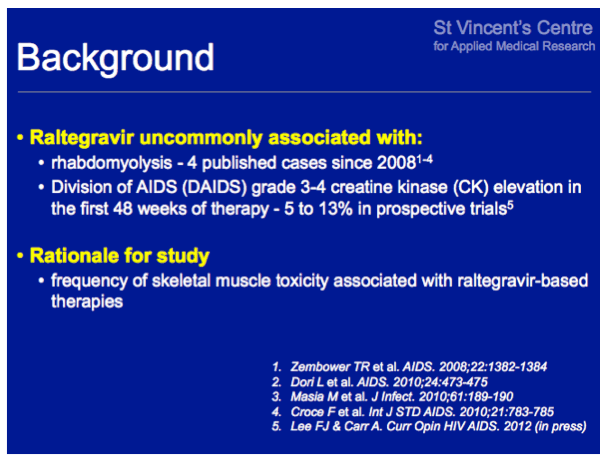
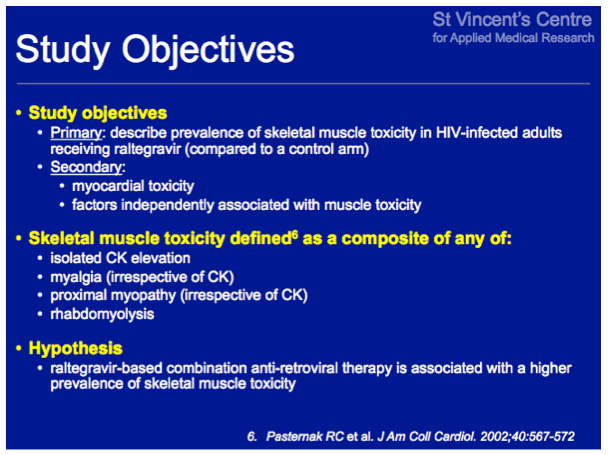
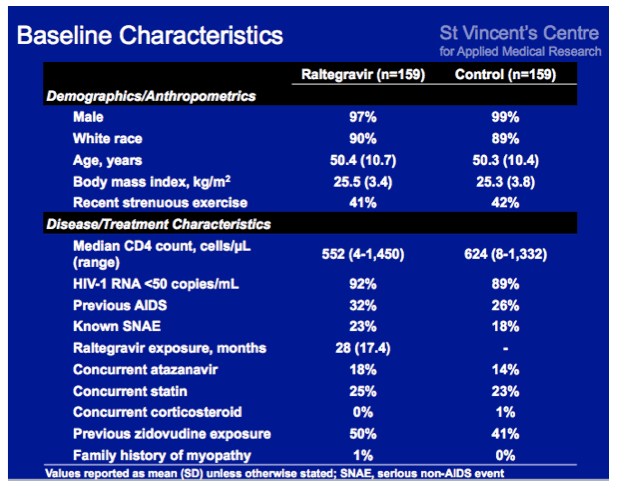
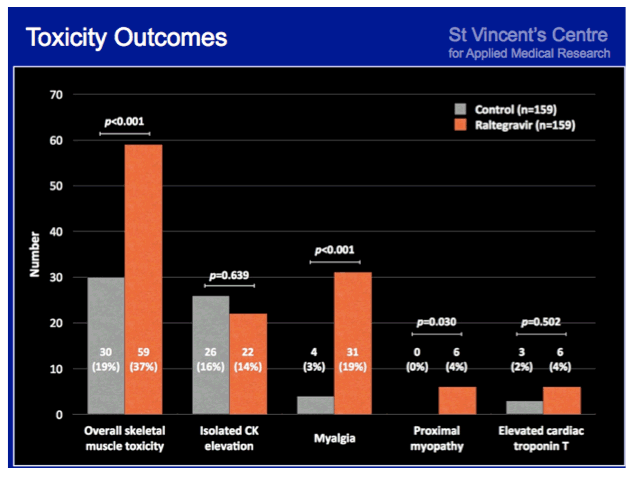
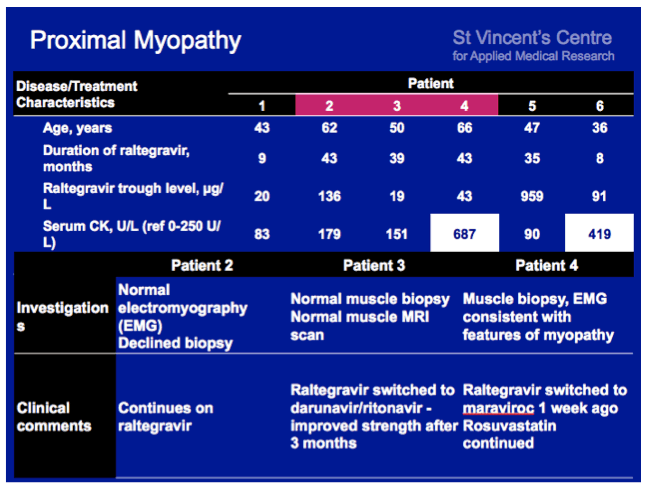

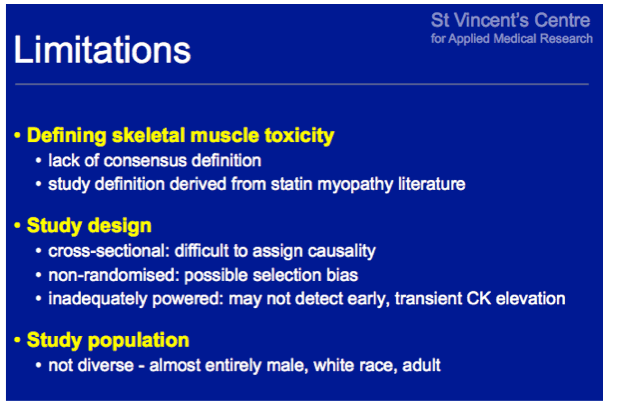

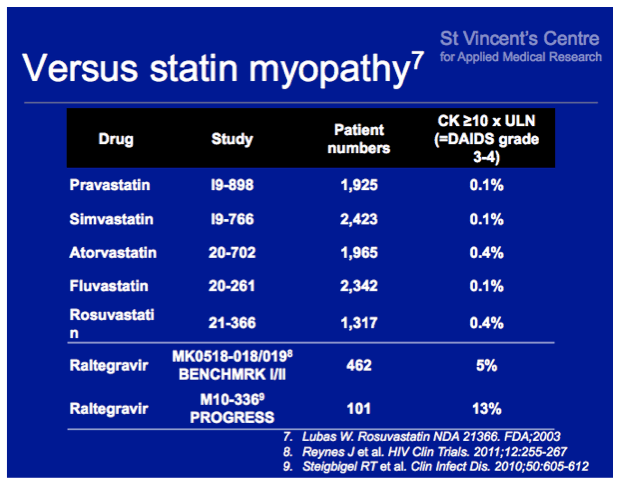
|
| |
|
 |
 |
|
|